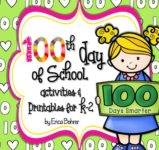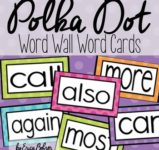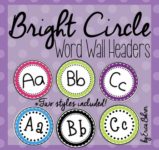This year, I changed my behavior systems over from a warning board to Classroom Dojo. I heard about Classroom Dojo from my amazing friend, Deedee Wills in this blog post. The kids love it, my principal loves it, the parents love it, and I love it! It is just this amazing, free, easy to use behavior system.
I like the Dojo system better than my old warning board because students can work their way out of a negative. With the warning board, they could not go backwards, a warning was a warning. With Dojos, the students can get negative points for negative behavior and also earn positive points for good behavior.
My students earn one prize from the prize box every time they reach an interval of five Dojos. So when they hit 5, 10, 15, 20, etc… they earn a prize. I keep a class list checklist to keep track of when a student earned his/her 5, 10. 15, 20th Dojo. That way if a student gets a prize for lets say five Dojos, and then gets a negative and goes down to four Dojos, and then earns a positive again and is back up to five Dojos, I know I already rewarded him/her their prize. Before Dojos I would give out tickets and the students would earn a prize for every five tickets they had. The ticket system worked, but also had its flaws. Students would lose tickets, students would steal tickets, and students would bring in tickets from home! The Dojo system is a much more organized system for earning points towards the prize box. I don’t let the students get their prize as soon as they earn the Dojo, I have them wait until the end of the day. Then our fifth grade helpers get out the clipboard and go to the Dojo display on the SmartBoard. They check off the students who earn prizes and tell them to go get one from the prize box. I reset the Dojo points every report card quarter. I find the longer you let it run, the bigger the gaps will be between the students. I don’t want the students to look down upon a classmate for having a low number of Dojos. Another way to avoid this problem, is to reset the Dojos each day or each week.
You can edit the behaviors to meet the needs of your students. Here are the positive behaviors I have for my Dojo system.
Here are the negatives behaviors:
I have a SmartBoard in my classroom where I display the Dojos. I like to use the SmartBoard because the students can easily go up and give themselves a Dojo whenever I tell them to. You don’t necessarily need a SmartBoard to utilize the Classroom Dojo system. You can also use a computer, an ipad, or an app on your iphone. I use the app while on field trips!
The system allows you to analyze behavior. Here is an analysis of my students’ behavior for this week.
Here is a behavior analysis of one student’s report for December.













I blogged about DoJo tonight too! I absolutely love it. I didn't know there was a countdown feature. I'm checking that out first thing in the A.M. Thank you!!
Marcy
Saddle Up For 2nd Grade
I love using Dojo too!! Thank you for the certificates- they'll be a great addition!
Christy
Crayons and Whimsy
I LOVE Dojo! My students each have a log sheet and, at the end of the day, fill in their points for the day. At the end of the week, if they didn't end any day that week in the negative, they get to choose a reward from my rewards board. It has been a great motivator for my students! I didn't know about the timer feature.. I can't wait to check it out!
Erica and other teachers, would you recommend this for pre-k students? I think they can handle it, but I was wondering if anyone has tried it with pre-k or kinder students? I think the negative numbers might confuse them a little, but nothing they probably can't learn with time. Also, would you recommend I finish my year out with my current behavior system (color clip chart- the students can move down and up) or do you think I can implement this new system to change things up? Any advice is appreciated 🙂 I also send home a behavior log calendar with the color students earn each day, I would likely have to think of some other way to inform parents about their child's behavior if I use Dojo. Overall, I almost don't want to wait until next year because it just looks effective and fun but I also know that maybe switching my behavior system on the students and parents might be too much for them.
This is perfect! My clip chart is good but I'm getting bored with it. I think this might be just what I need! Thanks for the very detailed descriptions.
Thanks! 🙂
Shelby
First Time Firstie
My school loves Class Dojo! We actually use it in our lunchroom (because we always have behavior problems there. It's seriously ridiculous!). Each student is a class. The classes then take those points and can earn parties or a trip to the student store. I use it in my classroom too! I have one "class" for table points and another "class" for the individual student points like you have set up. Unfortunately, I don't have any buy-in from my parents and most don't own a computer, but students and parents can get special codes to check their behaviors at home. Students can even change their avatar!
My son's teacher uses this and it is wonderful!
Thank you for sharing! I can't wait to start using this! Do you have a letter that you send home introducing it to your parents?
I started using Dojo with my Science and Language Arts classes last month, and I AM IN LOVE! I can't wait to use with my homeroom students next year!
Susie
Shafer's Shenanigans
I teach full day kindergarten and I use class dojo. However, I don't use the negative point feature. I only use the positive because that's what I want the focus to be on. I have loved using dojo but I am now running into a problem. My students will pick up garbage and come running over to me and ask, "Teacher, do I get a point for this? Can I get a point for pushing in my chair?" And so on and so on. My students are only doing good things when they could get a point but they aren't doing good things when they know they won't get a point. Any advice on how I can help my students develop intrinsic awards instead of relying on getting points for every good deed?
I tell my kiddos that if they ask for it, I can't give them a point. I or someone else must "catch" them, and the more good deeds they do, the more likely I am to notice!!!
Dojo also has a random student selection feature I use during a very quiet task. I will occassionally click on it and if the selected student is on-task, that student gets a point. We call it DOJO lottery.
QUESTION: What about on sub days or "my computer is evil" days? We are not allowed to have our passwords available, of course. So I am struggling as to how to modify for those days . . .
Love Dojo too! For the previous poster, to help children avoid asking for points you could use the dojo for goals. If a child needs to improve on something whether it's behavior, academic, or social, you could give Dojo points for that area and once they improve they get a new goal. Hope that helps!
Stephanie
Mrs. K's Teachable Moments
Class Dojo has a major flaw. Under this system children receive points for noticeably good behavior and noticeably bad behavior. Lets say a child receives a positive dojo point for being on task in the morning and then at the end of the day he or she gets chatty and receives a negative dojo point for talking out of turn. At the end of the day the parent sees that their child's behavior was only 50 percent positive for the day. But what of those unnoticeable vanilla moments that account for the largest part of the day where the child is performing as expected but not doing anything special to grab the teacher's attention? Class Dojo leaves those moments out of the equation. To see how flawed the logic is consider the following example. Lets say I have 10 jelly beans in my hand. One jelly bean is black, another is rainbow colored and all the rest are white. If I were to say 50 percent of the jelly beans in my hand are white would that be a correct assessment? No, of course not because I did not take into account the 8 white jelly beans. So back to the child whose Dojo reads 50 percent positive for the day because he or she got one positive dojo point and one negative point. Does that percentage accurately represent their overall performance for the day or just the two noticeable moments? For parents of wiggly, energetic boys this flawed calculation could create a false sense of failure.
You make a good point, but that is also why the teacher has to make points throughout the day for the whole class to earn dojos. My students earn for centers. After each center they can earn a "working hard" Dojo. Then again for math centers. The students who were not using their center time wisely simple don't earn a "working hard" and are not punished with a negative dojo. When the class gets a compliment, everyone earns a dojo. It is all how you use the system.
The problem is that busy teachers are unlikely to account for every moment of the school day with a dojo point and that is only way to arrive at a definitive percentage that accurately represents the child's overall performance for the day. On Monday my first grade son received 2 positive dojo points and no negatives and at the end of the day he was at 100 percent. On Tuesday morning I neglected to put his completed spelling homework in his backpack after reviewing it. It was my error not his. Yet on Tuesday morning my absent minded mommy moment resulted in a negative dojo point for no homework. He received no other positive or negative points on Tuesday. At the end of the day despite his good behavior and hard work his dojo says 66 percent positive and he is demoralized. Clearly his performance was not actually 66 percent positive for the two day period. But that is what the dojo says so the message to him is that most of his hard work and good behavior doesn't count. This system is a result of poor critical thinking on the part of the creators of Class Dojo.
I think that is something you should discuss with your child's teacher. I also don't know if you are aware but the teachers create their own positive and negative options. My Dojos are solely based on in-classroom behavior. You can also look at percentages over time and not just one day or week. It is very difficult for teachers to manage a class of 25 students, keep them focused, and teach them. We will take any tricks or helps we can get. You don't have to use the percentage portion if you don't want to. My students earn prizes for every 5 Dojo points. That alone motivates them. They don't seem to concern themselves with the percentages. Good luck with your child and again, if you have an issue with how your child's teacher manages the Dojo system, I suggest you speak with her/him. Suggest times for whole class Dojo points to bring up the percentages.
Prior to the advent of personal computer technology parents and teachers had the responsibility of managing and motivating the children in their care. I think it is kind of sad and a little bit scary that our dependence on laptops, smart phones and tablets has created a generation that cannot function or focus without the aid of an app.
What consequences do you use in your classroom?
How did you change the color of your icons for the negative points?